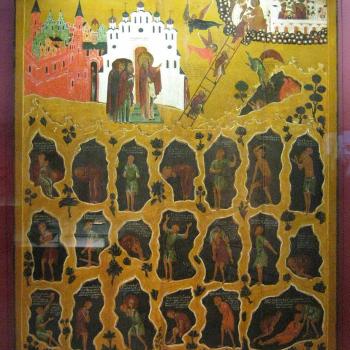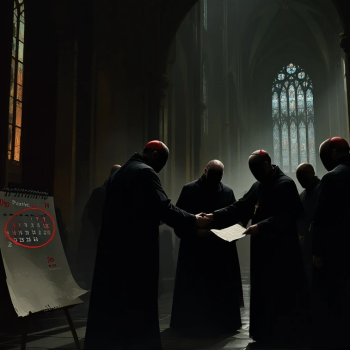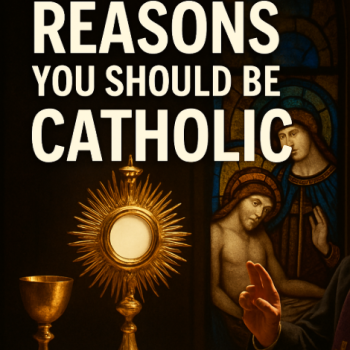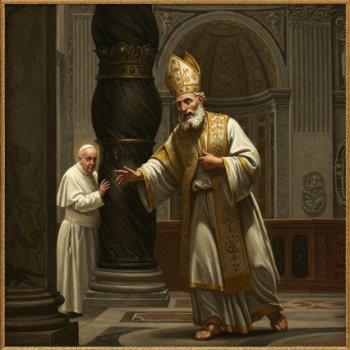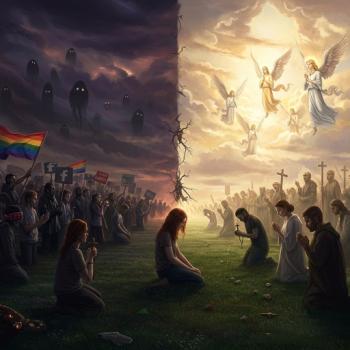 Why am I Catholic? Today marks the twenty-first anniversary of my admittance into full communion in the Catholic Church. At the Easter Vigil on April 14th, 2001, I ended my long journey to find Christ’s Church, a journey that began on August 28th, 1988.
Why am I Catholic? Today marks the twenty-first anniversary of my admittance into full communion in the Catholic Church. At the Easter Vigil on April 14th, 2001, I ended my long journey to find Christ’s Church, a journey that began on August 28th, 1988.
From Absence of Faith
To say I had no idea who Jesus was, and what he did for me, would be an understatement. My family was highly dysfunctional. Early in my life I witnessed alcoholism and drug use firsthand. It was not until I was 15 that I heard the Gospel for the first time. Ironically, it was through a friend of mine named Paul. I remember it like it was yesterday. Paul would come by my cousins’ apartment (where I was living after my family dissolved in divorce) and play roleplaying games with us. After we played, he showed us Christian music videos (this was 1988, so the quality was a bit lacking) and talk to us about Jesus. He mostly spoke to my cousins while I looked on, except for the one time he turned to me…
“Dennis, do you know that Jesus loves you and died for your sins?”
Stunned, I just stared at him and said nothing. My cousins seemed to mostly tolerate Paul during this time of our visits, so I did not want to draw attention to myself by saying one way for another. That night I prayed to Jesus for the first time but kept my thoughts and feelings to myself. I also prayed that He would touch my cousin’s heart so that I would have the courage to tell Paul what Jesus was doing in my heart. God answered my prayer on August 28th, 1988 (I later found out as a Catholic that August 28th is the Feast of St. Augustine of Hippo).
The Altar Call and Fundamentalism
On August 28th, 1988, Paul invited my cousin Brian and I to a “concert” at Calvary Chapel, Downey. With nothing to do, and not old enough to drive, my mom drove us. The “concert” was not really that great, to be honest. It was what happened at the end of the “concert” that mattered most: the altar call. For those not familiar with this term, an altar call is where a preacher (usually an Evangelical Christian of some kind) invites those who God is speaking to, to come up to the “altar” and “accept” Jesus into their heart as personal Lord and Savior. To my shock and amazement, Brian went up and I soon followed. I was later baptized on April 1st, 1989 (due to a knee injury that kept me from full emersion).
After graduation from high school, I volunteered at my local Bible Church. Considering my age at the time, the only real opportunity for ministry was the Middle School youth program. It was a rewarding time and one where I was first challenged theologically. Doug, the youth minister at the time, was in seminary (I cannot remember which one) and would discuss what he was learning. He asked me point blank if I had ever considered that my beliefs could be wrong. I honestly had no idea there were other views out there that were different than my own, except that Roman Catholics were not real Christians and that “all Popes went straight to hell” (this was an actual quote from the youth minister before Doug). This was the first step of my intellectual journey of faith.
Theological Evolution (Not Deconstruction)
Firstly, dispensationalism and all its fanciful fictions were the first beliefs I jettisoned. The idea that God would “rapture” his faithful before seven years of global judgement was truly only a 1st World” theological belief. Many Christians living in the developing world and in countries where persecution is the norm hold no such beliefs and could be said to be living in the horrors Dispensationalists predict will befall those “left behind.”
Next, I learned there were two main schools of thought regarding whether we choose God or if we are chosen by God for salvation. This is what is known as the debate between Arminianism (those of follow the view of Jacob Arminius and Calvinism (those who follow John Calvin). Arminius taught that humans have freewill, and when they cooperate with God’s grace, can freely choose to accept Christ as their Lord and Savior. Calvin, on the other hand, taught that men were totally corrupt and devoid of the ability to choose God unless first “quickened” or regenerated by the Holy Spirit. This regeneration grants the “chosen” to ability to choose Christ as one of the possible Elect. A life lived as faithful Christian to the end proved this election to God’s people. Ultimately, sided with the Calvinist by 1996.
Calvin, Luther, and the Early Church
Fast forward to 2000. After many years of faith and study of Reformed theology, I found myself in a group of budding intellectuals at Iowa State University. We started an Iowa State version of C.S. Lewis’ Socratic Club. Our goal was simple: invite people from all philosophical and theological backgrounds to discuss their views to create intellectual dialogue devoid of polemics and emotion. Our efforts had mixed results, but it was the impetus behind the effort that led me to the Catholic Church. Furthermore, it was an unwritten rule among our group that one could not truly hope to persuade anyone that their views were incorrect unless one truly understood those views as much as, or more than, those that hold them. As an anti-Catholic at the time, took it upon myself to tackle Catholicism to rescue those held captive in her deceived grip.
Moreover, starting at the beginning of Church history and with writers known as “The Early Church Fathers,” I read Ignatius of Antioch, Polycarp, Clement of Rome, Irenaeus of Lyon, and others. I enrolled in classes at Iowa State in Catholic Studies. The local parish (St. Thomas Aquinas) endowed a Chair of Catholic Studies that brought in different Catholic scholars to teach Catholic-themed classes at the university. As I read, one glaring fact kept coming up – an absence of my Protestant theology from the historical record, except in instances where they agreed with the Catholic Church.
The Journey’s End/New Beginning
As a Reformed Protestant, I believed in the solas: sola fide, sola scriptura, sola gratia, sola deo gloria, and solo Christo (by faith alone, by scripture alone, by grace alone, by God’s glory alone, by Christ alone). The more I read, the more I realized that two of the foundational solas did not exist in the early Church: sola fide and sola scriptura (by faith alone and by scripture alone). Please see my other writing on this where I go into greater detail, by clicking here, here, and here.
In conclusion, these revelations led to a theological crossroads. Either the Church fell immediately after the death of the Apostles (100 AD) or the Church I sought to destroy was the Church established by Christ. I also believed God’s words in Matthew 16:18 that “the gates of hell” would not prevail against Christ’s Church, therefore the Church could not fall. I entered the Catholic Church during the Easter Vigil on April 14th, 2001.
Here’s to twenty-one years in Christ’s Church!
Like what you read? Please check out my other writing here.
Please like and follow me on Facebook.






